Having very recently (https://www.thefirearmblog.com/blog/2017/11/06/imbels-ia2-based-subgun-carbine-prototypes/) written about submachine guns and pistol-caliber carbines currently under development at the Fábrica de Itajubá (Itajubá Factory) facility of IMBEL – Indústria de Material Bélico do Brasil, in Minas Gerais State, it just occurred to me to dig my old photo and info files in search of material to produce a how-it-all-started-type article on the company’s very early SMG prototypes. Some of them have, in fact, already been brought to the attention of TFB readers in previous editions, such as the FAL-based 9x19mm models of the late-1970s/early-1980s period (https://www.thefirearmblog.com/blog/2017/05/29/imbels-fal-derived-submachine-guns/) and a couple of .40 S&W prototypes of the late 1990s (https://www.thefirearmblog.com/blog/2017/07/12/early-40-sw-subgun-prototype-brazil/ and https://www.thefirearmblog.com/blog/2017/09/20/another-early-40-sw-subgun-prototype-imbel/). But I wanted to find the granddad of them all, and succeed I did!
Before being incorporated by the IMBEL conglomerate in 1975, Brazilian Army’s Itajubá Factory was mainly involved in the license manufacture of 7.62x51mm FAL (aka M964) rifles and Colt M1911A-type pistols in .45ACP and 9x19mm calibers. Actual submachine gun production in Brazil had , since the early 1950s, been the sole responsibility of I.N.A. – Indústria Nacional de Armas, whose facilities in Santo André, São Paulo State, manufactured large quantities of the .45 ACP M.B.50 and M953 SMGs, local derivatives of the 9x19mm Danish Madsen Model 1946. When these guns began to complete almost two decades in Army, Navy, and LE service, a 100% indigenous design was considered a proper replacement option to be tried in the late 1960s. My records indicate that the initial design was already on paper at the Itajubá facilities’ Oficina de Protótipos (Prototypes Workshop) by February, 1969, under the very generic designation “Sub. Mtr. (Sub Metralhadora) 9mm”.
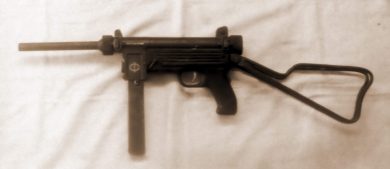
The very first Fábrica de Itajubá 9x19mm submachine gun design was the FI/70.
Prototypes were probably completed by 1970, as suggested by their FI/70 designation, the general design being as straightforward as possible. The tubular receiver housed a similarly-shaped bolt with a fixed firing pin, the gun firing from the open-breech position, with a small cylindrical charging handle 90 degrees to the right side and the ejection port, about 45 to the left. The 210mm barrel was attached to it by an integral mounting nut. The firing mechanism components (trigger, rear grip safety lever, etc.) were basically encased in a wooden structure that formed the lower receiver. A three-position fire selector lever was located on the left side, just aft of the magazine housing, settings being marked “S” (Segurança, Safety), forward; “R” (Repetição, Repetition), top; and “A” (Automático, Automatic), to the rear. The magazine release lever, pushed inward to actuate, was located on the forward part of the short housing.
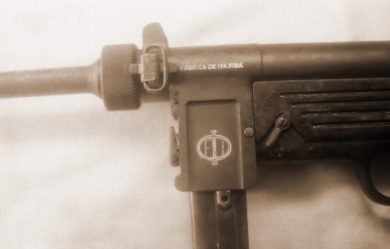
The FI/70 was fitted with a somewhat bulky wire-type stock that folded down and upwards to reduce the gun’s overall length from 745 to 450mm. The iron sights fitted offered a radius of 210mm, consisting of a two-position (100 and 200 meters) flip-type peep rear unit and front post, both adequately protected by sturdy ears. My personal reference data show that the SMG’s empty weight was 3.4kg, and that the actual cyclic rate of fire was of about 1,200 rounds per minute, 50% higher than the expected factory expectations’ 800 rpm.
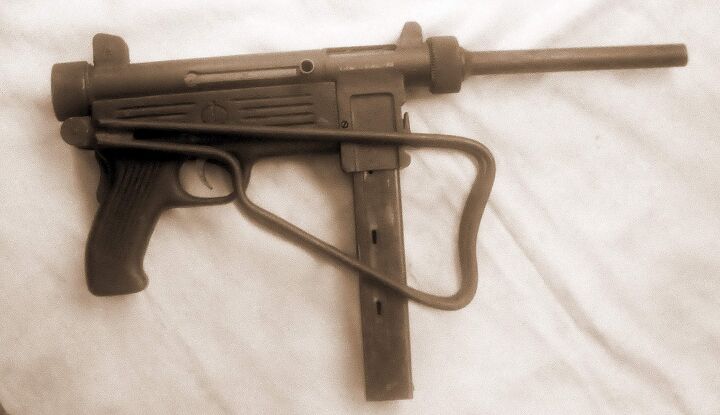

Side views of the FI/70 with the wire stock in the folded position, making it clear that it was a duplicated feature on both sides.

Removed from the gun, the 30-round magazine (staggered-row, two-position feed) shows the 10-, 20-, and 30-round observation openings (right side, only).

A different FI/70 prototype fitted with an apparently lighter, redesigned wire folding stock (broken near the hinge). Note the FI logo engraved on the non-ribbed wooden lower receiver.
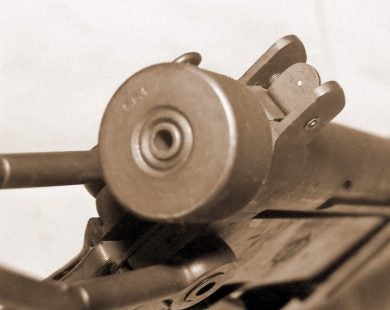

A closer view of the broken stock specimen’s rear and front sight areas.
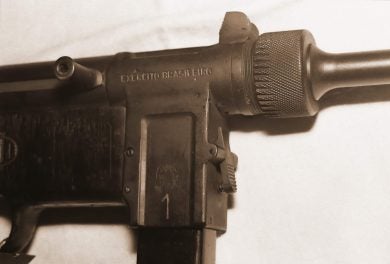
This photo of the same prototype’s forward area shows EXÉRCITO BRASILEIRO (Brazilian Army) marked on the upper receiver and the National Crest on the magazine housing, plus a large “1”. The weapon, however, never passed the prototype stage.
It is unknown to me how many of these FI/70 prototypes were actually built for the in-house test program, but the basic design was still gradually refined into follow-on examples that will soon be covered here. Successful or not, they are pieces of the local firearms history worthy of preserving (hear that, IMBEL?).
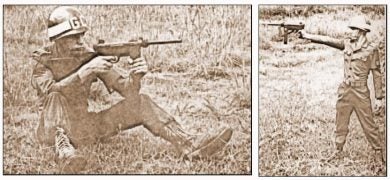
I’ve dug out these low-quality images from what appears to be a tentative promotional Fábrica de Itajubá brochure showing the FI/70 in the hands of a Brazilian Army soldier: “Look ma, one hand!”

Schematic drawings of the gun (top) with the bolt forward and partially blocked by the grip-safety unit, and (bottom) fully at the rear, ready to fire.
Higher-res pics? Sure: https://imgur.com/a/6ByaE
 Your Privacy Choices
Your Privacy Choices
